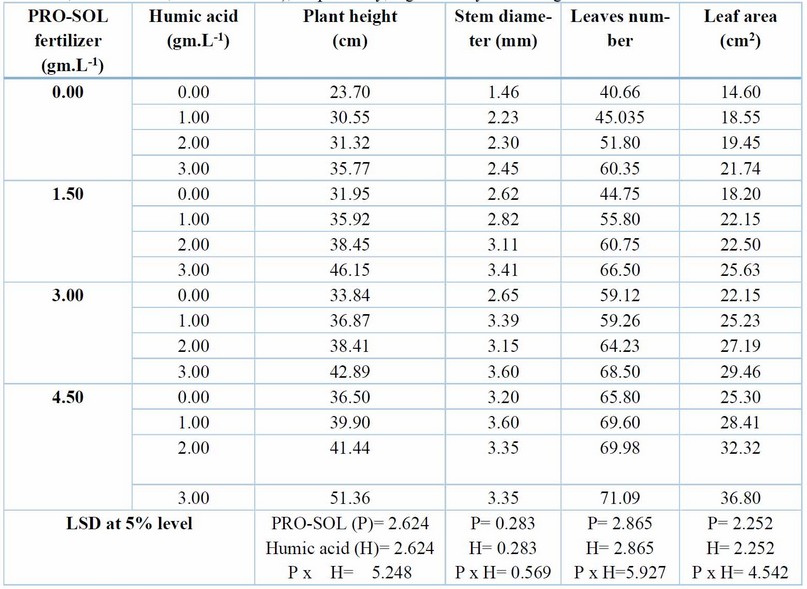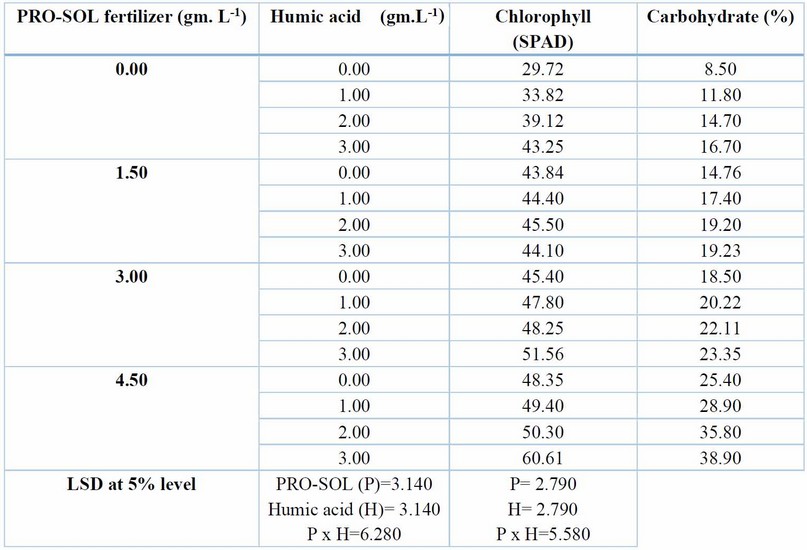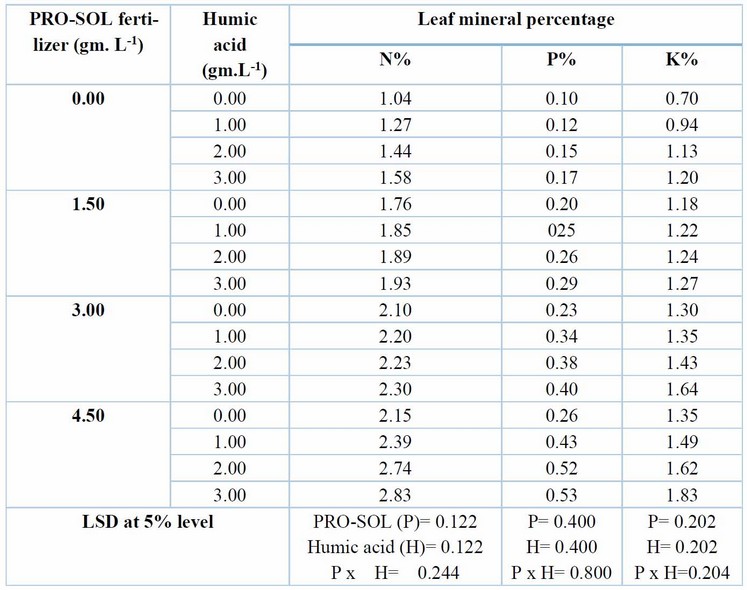2023.08.04.49
Files > Volume 8 > Vol 8 no 4 2023
Effect of foliar application with PRO-SOL and humic acid on some growth and chemical characteristics of sour orange (Citrus aurantium) seedlings.
Loai Hamzah 1,*, Farqad Al Dabbagh 2, Mohammed Ibrahim 1
1 Agriculture College/AL- Qasim Green University/ Babylon/ Iraq. [email protected].
1 Agriculture College/AL- Qasim Green University/ Babylon/ Iraq. [email protected].
2 Ministry of Agriculture, plant protection office/ Baghdad/ Iraq. [email protected].
* Correspondence: [email protected];Tel.:009647723809066.
Available from. http://dx.doi.org/10.21931/RB/2023.08.04.49
ABSTRACT
This study was carried out on six months old sour orange (Citrus aurantium) seedlings in the lath house/ Agriculture College/AL-Qasim Green University in Babylon province, Iraq, from March 2020 to October 2020 with aim of investigating the impact of spraying PRO-SOL fertilizer (0.0, 1.5, 3.0 and 4.5) gm.L-1 and Humic acid (HA) (0.0, 1.0, 2.0, and 3.0) gm.L-1 independently or in combination on the vegetative and chemical characteristics of sour orange seedlings. In 2021, a factorial experiment with three replications was conducted on local sour orange seedlings. The findings indicated that spraying with PRO-SOL fertilizer at a concentration of (4.5 gm.L-1) and HA (3 gm.L-1) promoted the seedling growth indices(the height of the plant, diameter of stem, number of leaves, and area of leaf), chemical parameters (chlorophyll and carbohydrate percent) also the leaf mineral content of N, P, and K.
Keywords: PRO-SOL; HA; Foliar spray; Citrus aurantium seedling; lathhouse; Organic fertilizer.
INTRODUCTION
The sour orange (Citrus aurantium)rootstock is widely planted in Diyala province (East of Iraq), and according to the latest statistics from the Iraqi planning ministry, there are about 753329 sour orange trees with a mean productivity of 28.5 kg.tree-1 and total production reached 165779 tons1. In Iraq, sour orange trees have adapted to the local soil and are compatible with other citrus species, particularly orange trees. Aside from its beneficial impacts on fruit productivity and quality, sour orange trees, according to their ability to grow and develop well in salty soil 2, 3. Its fruit juice is highly nutritious as it is rich in minerals like P, K, Ca, Mg, S, Na, Fe, vitamin C, and many other compounds that are very useful to human health4. For growth and development, sour orange trees need the support of essential nutrients to perform essential biological and metabolic functions during plant growth and development5. Taking care of the bushes, fertilizing them with macro and microelements, and spraying techniques help encourage growth and prevent fertilizer consumption via the soil, which can lead to loss due to immobilization6. Foliar spraying of mineral fertilizers like PRO-SOL via sprinkles provides a more efficient means of supporting nutrients to many fruit seedlings. It considerably impacts the growth of the vegetative and root systems7, 8, 9, 10, 11. Organic fertilizer, whether applied to the soil or sprayed on the vegetative system, is a significant resource for providing plants with the required nutrients without negative effects10. Humic acid is among the most essential forms of organic fertilizers because it contains oxygen (31-40%) and nitrogen (2-4%), which allows it to remain for long periods to increase soil fertility and plant nutrition10. Many studies have already detected that HA plays a beneficial impact in many aspects of vegetative development, including leaf number, the height of the plant, and leaves chemical content11, 12, 13, 14.
MATERIALS AND METHODS
According to Drebee and Abdul Razak15, 144 homogenous sour orange seedlings were planted in plastic carrier pots containing a 3 1 combination of river soil and peat moss as a planting medium. Table 1 shows the results of the physiochemical assessment of the experimental soil.

Table 1. Some physical and chemical traits of soil.
This experiment was conducted according to Randomized Complete Block Design (RCBD) involving two factors and their combination with three replications using three seedlings for every experimental unit. The first factor was foliar spraying with four concentrations of PRO-SOL fertilizer (0.0, 1.5, 3.0 and 4.5) gm.L-1 Table 2. shows the content of PRO-SOL. Additionally, the second factor, humic acid (0.0, 1.0, 2.0, and 3.0) gm. L-1. During the experimental season, the sour orange seedlings were applied thrice with PRO-SOL and humic acid individually:
· In the spring season, the first spray was on 15/3/2020, the second on 1/4/2020, and the third on 15/4/2020 (PRO-SOL foliar spray). HA was applied two days after each spray: the first was on 17/3/2020, the second on 3/4/2020, and the third on 17/4/2020.
· In the fall season, the first spray was on 15/8/2020, the second on 1/9/2020, and the third on 15/9/2020 (PRO-SOL foliar spray). HA was applied two days after each spray: the first was on 17/8/2020, the second on 3/9/2020, and the third on 17/9/2020.

Table 2. The content of PRO-SOL fertilizer (% macro and microelements) is stated in the company newsletter.
The control treatment was sprayed with distilled water, and the Tween 80 was added to every treatment solution as a surfactant, applied directly on seedlings (in the early morning). This study consisted of 16 interacted treatments with three replications and three seedlings for every experimental unit (16 X 3 X 3=144 seedlings). The genstat program was used to analyze the data statistically and compare the mean values by using LSD at a 5% level of significance16. After the end of the growing season, which falls in mid-October, morphological and chemical traits and their means value were recorded on each of the three replicate seedlings. Vegetative growth characteristics:
· Plant height (cm) was calculated by measuring from the ground surface to the plant's highest point.
· The diameter of the stem was estimated in mm using vernier.
· The leaves number is established on seedlings.
· Leaf area recorded by using the following equation17:
Leaf Area (cm2) = 0.70 × (Leaf length × Leaf width) - 1.06
· SPAD 502-chlorophyll meter18 determined the total chlorophyll in leaves.
· Total carbohydrates (%) were calculated using Joslyn's (1970)19 method.
· The status of plant nutrition was measured by calculating the nutrient elements: N (by Kieldahl method), P (by spectrophotometer), and K (by flame photometer).
RESULTS
Vegetative growth traits
Table 3. Data shows that spraying seedlings with PRO-SOL fertilizer and HA at various concentrations significantly increased all tested vegetative parameters (plant highest, stem diameter, leaf number, and leaf area) compared to the control treatment. The dose of fertilizer is known to be important in vegetative growth traits; optimum percentages of plant height (36.50 cm), stem diameter (3.20 mm), leaves number (65.80 leaves), and leaf area (25.30 cm2 ) were noticed on treatment supplemented with 4.5 gm.L-1 PRO-SOL fertilizer. Also, the applied treatment with HA (3 gm.L-1) had the most outstanding characteristics (35.77 cm, 2.45mm, 60.35 leaves, 21.74 cm2), respectively. A highly significant (P≤0.05) interaction between PRO-SOL (4. 5gm.L-1) and HA (3gm.L-1) was shown. The greatest mean of the mentioned characteristics was (51.36 cm, 3.35 mm, 71.09 leaves, and 36.80 cm2), respectively, significantly exceeding all other treatments.

Table 3. Impact of vegetative fertilization of PRO-SOL and humic acid at varying concentrations in some foliar development traits of sour orange seedlings.
The chemical parameters
Chlorophyll and Carbohydrate
The data in Table 4. demonstrated that the higher fertilizer concentration increased chlorophyll and carbohydrate content, 4.5gm.L-1treatment achieved the highest value of chlorophyll (48.35 SPAD) and carbohydrate (16.70 percent). Notably, 3 gm of HA per liter of water had the highest average of mentioned parameters (43.25 SPAD) and(16.70%), respectively, compared with zero concentrations. Table 4 presents the positive response of the target plants to chlorophyll and carbohydrate content resulting from the foliar application of PRO-SOL and HA. The gained data demonstrate significant differences within the treatments, with the greatest mean of chlorophyll (60.61 SPAD) and carbohydrate (38.90 percent) at the combination of PRO-SOL concentration (4.5 gm.L-1) and HA (3 gm.L-1). The lowest mean was achieved by control treatment on the same parameters (29.72 SPAD) and (8.50 percent) respectively.

Table 4. Vegetative applying influence of PRO-SOL and humic acid in chemical properties of sour orange seedlings at varying concentrations.
Leaves content of N, P, and K
N, P, K leaves content significantly achieved with fertilizer, where the largest average (2.15% (N), 0.26% (P), and 1.35% (K)was noticed in plants treated with 4.5 gm.L-1PRO-SOL (Table 5.). Also, the table's findings show that as the humic acid dose increased (3gm.L-1), more leaves the content of N, P, and K percentages were recorded (1.58, 0.17, and 1.20)%, respectively. The data is in Table 5. clearly shows a linear increase in the content of N, P, and K. and that PRO-SOL foliar applied at the highest dosage (4.5 gm.L-1) combined with HA (3gm.L-1) surpassed the other treatmentssignificantly, reaching 2.83% (N), 0.53% (P), and 1.83% (K), while the control had the lowest availability of N (1.04%), P (0.10), K (0.70).

Table 5. Vegetative spraying influence of PRO-SOL and humic acid at varying concentrations in leaf mineral content of sour orange seedlings.
DISCUSSION
Vegetative growth traits
The significant impact of PRO-SOLfertilizer and HA on the vegetative traits (plant highest, stem diameter, leaves number, and leaf area)may belong to their role in supporting plants with mineral elements that are required for photosynthesis, also encouraging the growth of new tissue, promote photosynthesis, protein synthesis and other biological pathways in balanced amounts throughout cell division and elongation7. These results agreed with those recorded by AL-Zuhairi et al.6, Al-jury and Al-Maamouri20, Abbas et al.21 and Hamza and AL-Dabbagh22.
The chemical parameters
Chlorophyll and Carbohydrate
Chlorophylls and some other pigments are vital factors in the photosynthetic apparatus. Their involvement in light energy harvesting, membrane stability, and energy transduction has been well investigated9. The increase in this parameter may be attributed to the mineral fertilizer and organic elements' roles in activating several key enzymes, resulting in auxins, cytokines, and gibberellins production, which indirectly affect chlorophyll content formation7. The statistical analysis found that foliar sprays of mineral and organic elements enhanced leaf carbohydrate content, which may be attributed to photo assimilate metabolism and transport23, 24.
These findings are similar to those of EmadEldin and Hussein25, Abboatta and EL-Azazy26 and Hamza and AL-Dabbagh24.
Leaves content of N, P, and K
HA application enhanced the permeability of cell membranes, resulting in higher nutrient absorption across these membranes and, consequently, increased nutritional content in plant leaves14. Furthermore, about fertilizer foliar spraying, Umar et al. 27 explained that the exogenous application appears to have the disadvantage of high concentrations, uniform nutrient distribution, and rapid absorption stimulation by the plant. In contrast, the micronutrient foliar spray is tested to be more reliable. These findings agree with Hassan8, Al-Abadi, and Abd Al-hayany14 and Hamza and AL-Dabbagh22.
CONCLUSIONS
From this study, data obtained showed that a triplicate application of multi-nutrient foliar fertilizer (PRO-SOL) (4.5 gm.L-1) combined with humic acid (3 gm.L-1) led to a significant increase in all studied characteristics. The most essential vegetative and chemical responses were produced by fertilization at the spring and fall seasons of growth. This improved vegetative growth indices, chemical parameters, and leaf content of sour orange seedlings N, P, and K.
Author Contributions: Loai Hamzah.; methodology, Farqad Al Dabbagh; writing— original draft preparation, Mohammed Ibrahim.; conceived the project and editing.
Funding: This research received no external funding
Acknowledgments: Special thanks and gratitude to everyone who contributed to overcoming our difficulties during the study.
Conflicts of Interest: The authors declare no conflict of interest.
REFERENCES
1. Iraqi Agriculture Statistics. Statistics Affairs sector, Ministry of Planning, Iraq.2019.
2. Koulympoudi, L.; Papafilippou, A.; Tzanoudaki, M.; Chatzissavvidis, C.; Salamalikis, V. Effect of nitrogen form on trifoliate orange (Poncirus trifoliata (L.) Raf.) and sour orange (Citrus aurantium L.) plants grown under saline conditions. J. Plant Nutr. 2021,1-13. https://doi.org/10.1080/01904167.2021.1918713.
3. LÜtfyi, Ş.; Tuzcu, Ö. Fruit quality of Valencia orange trees grafted on Volkameriana and sour orange rootstocks grown in two different regions in Northern Cyprus. Pak. J. Bot.2020, 52, 1803-1808. DOI: http://dx.doi.org/10.30848/PJB2020-5(12)
4. Torshizi, M. V.; Mohsen, A.; Kashaninejad, M. Application of response surface method to energy and exergy analyses of the ohmic heating dryer for sour orange juice. Fuel, 2020,278, 1-13. https://doi.org/10.1016/j.fuel.2020.118261
5. Mahmood, N. A., and Abdulateef, S. M., Determining Some Undesirable Behavioral Traits and Their Impact on the Behavioral Performance of Broiler Chicks, in IOP Conference Series: Earth and Environmental Science, 2021, vol. 904.
6. AL-Zuhairi, F. F. A.; AL-Aareji, J. M. A.; AL-Taae, A. K. Effect of nano and regular iron spraying and biofertilization on growth of local lemon transplants Citrus limon L. budded on sour orange. 2nd Virtual International Scientific Agricultural Conference. Series: Environ. Earth Sci. 2021, 735, 1-6. DOI 10.1088/1755-1315/735/1/012045
7. Al-Tamimi, H. M. A.; Ali, A. A. ; Kadhim, Z. K.; Shatti, R. H. Effect of foliar spraying with Grew More and Scott on improving some vegetative and root growth characteristics of citrus seedlings Swingle citrumelo. Biochem. Cell. Arch,2020,20, 2, 4201-4205. https://connectjournals.com/03896.2020.20.4201
8. Hassan, A. M. Effect of foliar application date of PRO-SOL fertilizer and some plant growth promoters on growth of naval orange saplings. Sci. J. of Kerbala Univ (JKAS)2017,15, 4, 36-44.
9. Kemira, G. H. Application of micronutrients: pros and cons of the different application strategies. IFA International Symposium on micronutrients. Internet/International fertilizer industry Association. New Delhi, India.2004.
10. Nardi, S.; Pizzeghello, D.; Schiavon, M.; Ertani, A. Plant bio stimulants: physiological responses induced by protein hydrolyzed-based products and humic substances in plant metabolism. Sci. Agric2016,73, 1, 18-23.
11. Mansoor, S. S.; Al-Esawi, J. S. . .; Al-Falahi, M. N. Assessing The Efficiency Of Cement Kiln Dust For Heavy Metals Removal From Simulated Polluted Water. JLSAR 2023, 4, 45-52.
12. Sebastiano, D.; Tognetl, R.; Desiderio, E.; Alvino, A. Effect of foliar application of N and humic acids on growth and yield of durum wheat. Agron. Sustain. Dev.2005,25,183–191. DOI: 10.1051/agro:2005017
13. Omar Khaled Attallah, Thafer Thabit Mohammed and Nasr Nuri Al-Anbari. Effect of Adding Grape Pomace and Resveratrol on Some Physiological Traits and Gene Expression to Prevent Hemorrhagic Fatty Liver Syndrome in Laying Hens . IOP Conference Series: Earth and Environmental Science.2022, 1060 (1), 012076. doi:10.1088/1755-1315/1060/1/0120 .
14. Al-Abadi, M. H. A.; ABD Al-hayany, A. M. Effect of humic and salicylic acids foliar application in the chemical content of Papaya seedlings. Fourth International Conference for Agricultural and Sustainability Sciences Fourth International Conference for Agricultural and Sustainability Sciences. Ser.: Earth Environ. Sci.2021, 910 012039. doi:10.1088/1755-1315/910/1/012039.
15. Drebee, H, A.; Abdul Razak, N. A. The Impact of Corruption on Agriculture Sector in Iraq: Econometrics Approach. IOP Conference Series: Earth Environ. Sci.2020, 553, 1.
16. Al-Rawi, K.M.;Khalaf Allah, A, M. Design and Analysis of Agricultural Experiments. The Revised Version. Dar Ebein Al- Atheer for Printing and Publishing, University of Mosul, Iraq, 2000,488. (In Arabic).
17. Ali, H.H., AL-Rawi, K., Khalaf, Y., Alaaraji, S., Aldahham, B., Awad, M., Al-ani, O., Al-ani, F., Ali, A.T.Serum Caveolin-1 Level is Inversely Associated with Serum Vaspin, Visfatin, and HbA1c in Newly Diagnosed Men with Type-2 Diabetes.Reports of Biochemistry and Molecular Biology,2022, 11 (2), pp. 299-309.
18. Ling, Q.; Huang, W.; Jarvis, P. Use of a SPAD-502 meter to measure leaf chlorophyll concentration in Arabidopsis thaliana. Photosynthesis research 2011, 107, 209-214.
19. Shah, S. H.; Houborg,R.; McCabe, M. F. Response of Chlorophyll, Carotenoid and SPAD-502 Measurement to Salinity and Nutrient Stress in Wheat (Triticum aestivum L.). J. Agron.2017, 7, 61; doi:10.3390/agronomy7030061.
20. Joslyn, M. N. Methods in food analysis (2nd ed.). Academic Press, New York, London.1970 .
21. Al-juthery, H. WA; Al-Maamouri, E. H. O. Effect of Urea and Nano-Nitrogen Fertigation and Foliar Application of Nano-Boron and Molybdenum on some Growth and Yield Parameters of Potato. Al-Qadisiyah. J. Agricult. Sci. 2020, 10, 1,253-263.
22. Abbas, T.; Ahmad, S.; Ashraf, M.; Shahid, M. A.; Yasin, M.; Balal, R. M.; Pervez, M. A.; Abba, S. Effect of humic and application at different growth stages of kinnow mandarin (Citrus reticulate Blanco) on the basis of physio-biochemical and reproductive responses. Academia J. Biotech. 2013,1, 1, 14-20.
23. Hamza, L. M.; AL-Dabbagh, F. M. K. The promotive impact of foliar spray of AGE and KCl on vegetative characteristics and nutrient status of lemon seedlings. Int. J. Agricult. Stat. Sci. 2020,16, 1, 1371-1374. https://connectjournals.com/03899.2020.16.1371
24. Sh. Kader, J. Study The Effect Of Foliar Application Of Gibberellic Acid (Ga3) And Liquid Calcium On Growth And Fruit Quality Of Pomegranate Trees (Punica Granatum L.) Cv. Sawa. Anbar Journal Of Agricultural Sciences, 2023; 21(1): 71-86. doi: 10.32649/ajas.2023.179717.
25. Hamza, L. M.; AL-Dabbagh, F. M. K. Impact of Nanoparticle and Salicylic Acid Foliar Spraying in the Growth of Sour Orange Seedling. Annals of R.S.C.B.2021, 25, 3, 4384 – 4391.
26. EmadEldin, H. A.; Hussain, M. A. Foliar Application of Micro Silica, Potassium Chloride and Calcium Chloride Enhances Yield and Fruit Quality of Balady Orange Tree. Alexandria Sci. Exch. J.2018, 39, 3, 387-393. https://doi.org/10.21608/asejaiqjsae.2018.9955
27. Abboatta, W.F.; EL-Azazy, A. M. Role of organic and biofertilizers in citrus orchards. Aswan University Journal of Environmental Studies (AUJES). 2020,1, 1, 13-27. https://dx.doi.org/10.21608/aujes.2020.124530
28. Umar, S.; Bansal, S.; Imas, P.; Magen, H. Effect of foliar fertilization of potassium on yield, quality, and nutrient uptake of groundnut. J. Plant Nutr. 1999, 22,1785–1795. https://doi.org/10.1080/01904169909365754
Received: 26 September 2023 / Accepted: 15 April 2023 / Published:15 December 2023
Citation: Hamzah, L.; Al Dabbagh, F.; Ibrahim, M. Effect of foliar application with PRO-SOL and humic acid on some growth and chemical characteristics of sour orange (Citrus aurantium) seedlings. Revis Bionatura 2023;8 (4) 49. http://dx.doi.org/10.21931/RB/2023.08.04.49
Publisher's Note: Bionatura stays neutral concerning jurisdictional claims in published maps and institutional affiliations.
Copyright: © 2023 by the authors. Submitted for possible open-access publication under the terms and conditions of the Creative Commons Attribution (CC BY) license (https://creativecommons.org/licenses/by/4.0/).
